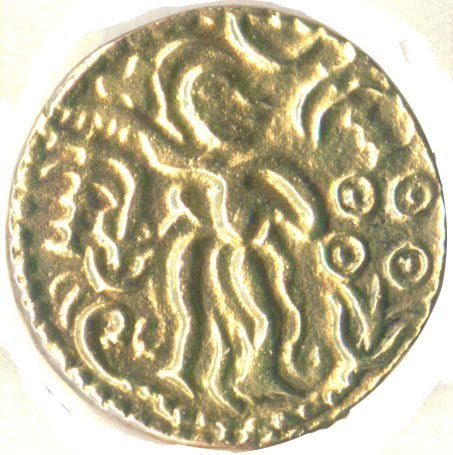| SPECIFICATIONS | |
| Denomination | One Kahavanu |
| Metal | Gold 0.60 |
| Alloy | Ag%Cu 0.49 |
| Type | Struck |
| Diameter | 19.2 mm |
| Thickness | 2.8 mm |
| Weight Std. | 4.54 gms |
| Weight | 5.0 gms |
| DieAxis | 180° |


|

| 
| ||||||||||||||||||||
| Codrington unlisted ; OMRS-21 | ||||||||||||||||||||||
| 1 | 2 3 | 4 5 |
| Sri | Lanka | Vibhu |
The Kahavanu was scanned at 600dpi and displayed at 300dpi. It was purchased in July 1993 from Spink & Sons Ltd, at ANA coin show in Baltimore, USA.
In 1993, I was surprised to find Medieval Gold coins from Lanka on sale at a coin show held in Baltimore, USA, where I was working. It motivated me to resume this collection after 25-years.
Not knowing much about these gold coins at that time, when I questioned if the coin was genuine, the dealer replied with their authority as Spink of London, founded in 1666. However this coin is over 10% heavier than expected weight, and much heavier than any published Medieval Lankan Gold Kahavanu. XRF measurements in 2015 August showed it also has less silver than copper, which is not typical of other Type I and Type II gold coins which normally have 3 to 5 times more Silver than copper. These factors indicate, it is probably a coin made for collectors in 20th century.
A Comment was made 1907 John Still's paper in the Journal of the Royal Asiatic Society Ceylon Branch, Vol 19 #58 161-216. On page 164 he puts a footnote to the word "genuine" I quote " How rare genuine specimens are I am inclined to think very few people thoroughly recognize. Gold "Lankesvaras" and "Vijaya Bahus' are turned out wholesale in Kandy now, and are so skillfully done that most of them are duly absorbed into collections. The improved manufacture of late is marked"
I also find it curious that this is the only Full kahavany coin type that I have which is not listed in Codrington's Coins and Currency of Ceylon. It would be interesting to XRF study other specimens of same type in other collections.
So the coin I used for 18 years as a logo for this website has lost it's charm. It reflects that even leading Numismatic firms probably do not have the expertise you assume they do, on ancient coins they rarely handle on a regular basis. When collecting such coins, one needs to read the literature, do your own research and become your own expert.
In 2018 in reply to a comment I made about this coin on Moneta-L Robert Kokotailo said On Bahirava's right knee, left on the coin, I see a fairly large perfectly round depression, with many other smaller ones scattered around the surfaces. If they look on the coin the way they appear on the image, you can safely assume this was made by lost wax casting. If so there will be a sprew removal point on the edge which will either be a small filed area if they did not try to hide it, but more likely a small smoothed spot if they did.
Unless those perfectly round depressions are an illusion of the image, this coin should not pass inspection by an experienced numismatist even if he is not experienced in this specific type.